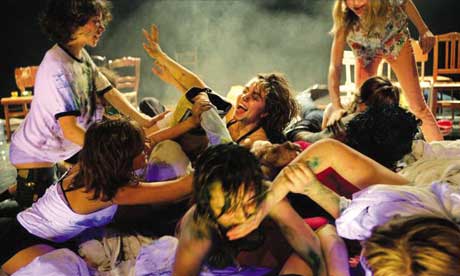

 DRIFT '08
DRIFT '08Illuminate Productions
London's First Annual Art Exhibition on The River Thames
Please see Iluminate Productions for information on all 7 contemporary art installations as a part of Drift '08.ArtistCraig Walsh (Austrailia)
TitleClassification Pending
Medium
Hyper-Real Projection
Location
North Side of London Bridge looking towards the TATE Modern
"Witness a new life form living in the Thames. These mythical creatures will evolve to form a family unit during the course of DRIFT. Only appearing at dusk, they will develop into an apparition - like the creatures of folklore before them."
Maybe I have been feeling particularly lonely since moving to a new country two-odd weeks ago. Perhaps it's that time of the month and my uterus wants to be noticed. (They do that sometimes.) Or I could just be a sap. But the sight of baby sea monsters finding one another in the Thames River and learning to live in a family unit (nuzzling, playfully dodging waves and one another, all the while whiskers twitching) makes me want to do nothing more than take the artist home and cuddle. Would that be creepy? Probably. But the offer stands. Classification Pending is my favorite piece I have stumbled on during DRIFT '08. It tells the viewer a story of the place the art is set, the characters within it, and makes the audience care about all of the above. As a theater practitioner, I recognize this as no easy feat. The quality of the projections is lovely, although I look forward to 20 years from now when we find a way to eradicate the telling projection boxes of light that are a giveaway to the installation.
ArtistAndy Harper (United Kingdom)
TitleFeast of Skulls
Medium
Oil on Steel
Location
River Walkway by Shakespeare's Globe
"Weird and wonderful plant-like forms are painted directly onto a river buoy. The plants appear to be growing, morphing and climbing the buoy."
A smart piece with clean brushstrokes and joyful colors, this buoy holds a secret. Interwoven within a maze of fish, flowers and algae the viewer stumbles across the dark remains of several skulls floating amist the debris of human bones. I appreciated how much joy the artist brought to his macabre subject and found the bouy to vastly improve it's section of walkway along the river, in reality an unforunate locale for this piece. I would have liked to come across this on a piece of beach, washed ashore and thick with rust. As it was, the tourist and commuter traffic heavy locale distracted from it's fine mix of art realism.
ArtistMariele Neudecker (Germany)
TitleMuch Was Decided Before You Were Born (2)
Medium
Sound Installation
Location
Millennium Bridge
"A seaside soundscape disorientates passers-by, surrounding them with the sound of waves, seaside chatter and the cries of seagulls."
The soundscape on Millennium Bridge is, along with the Blackfriars ghost bridge, conceptually one of my favorite pieces. Unfortunately, like the Ghost Bridge, it seems a halfhearted effort. I did notice the crying gulls before I knew there was an installation here, but I long for a better thought out system, where you didn't only come across the one sound at the one point. Rather, why not explore a variety of sound at a variety of bridge locations? Sensorally, the piece works. There is something very comforting to me personally, as a childhood seaside veteran to the crashing of waves and crying of gulls. I only wish I could get more excited about it.









